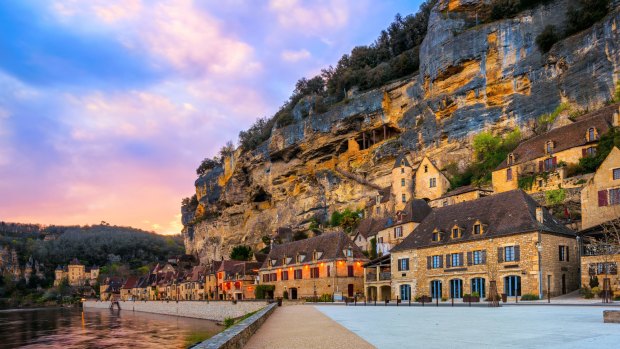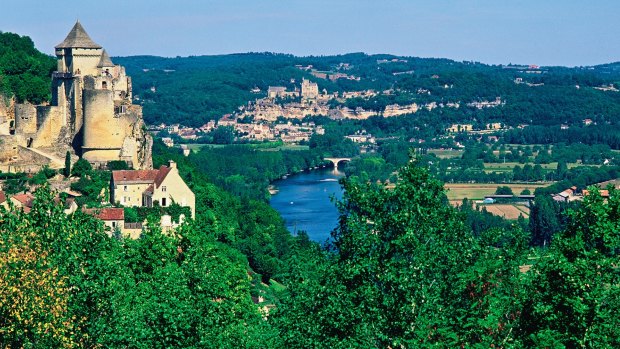This was published 4 years ago
An 8-day electric bike cycling trip through Dordogne, France: The dazzling 'valley of 1000 castles'
By Alison Stewart

La Roque-Gageac, one of the most beautiful villages of France (Les Plus Beaux Villages), in dramatic sunset light. Credit: iStock
Cycling "en plein air" in the Dordogne is like gliding into an impressionists' masterpiece. Around every corner, the flower-stippled green, purple and honey-drenched landscape glows under the region's distinctive light.
But the Dordogne is not simply a pretty picture. The region is enhanced by an unusually rich heritage and culture. The French call it a land with "un peu de tout". A slow cycle is a perfect way to trace these ancient paths through a landscape that does indeed offer "a little of everything".
People have come to the Dordogne-Perigord in France's south-west Aquitaine region from prehistoric times, drawn by its navigable rivers, rich soil, benign climate and the haven of its limestone cliffs and caves.

The Dordogne Valley is filled with fortified towns and castles.Credit: J-Jacques Brochard
The region has been heavily contested, hence the proliferation of medieval "bastide" towns, fortified chateaux and, in the case of the remarkable La Roque Saint-Christophe, an entire multi-storeyed troglodyte fortress city built into the cliffs above the Vezere River. The Dordogne is, in fact, the "valley of 1000 castles".
Everyone has wanted their slice from the Neanderthals, Romans and Vikings to England's Richard the Lionheart. So our UTracks eight-day cycle tour around the Dordogne is a futuristic ride back in time. Futuristic, because to properly embrace the region's ancient history and culture, we lighten the load with e-bikes.
The truth is, the Dordogne's dazzling landscape of rolling hills, limestone crags and the deep valleys of the Dordogne and Vezere rivers, make for some challenging leg-driven cycling.
The 220-kilometre round trip from Souillac (with six cycling days, rated a moderate 3/5) offers modest daily distances, from about 30 kilometres to 54 kilometres. However, the terrain is graded "hilly" and the route notes are littered with multiple long, sharp climbs of up to 2.5 kilometres. France is cycle-friendly but our route mostly avoids main roads, taking us instead along secondary roads, lanes, "pistes cyclables" and river paths.
E-bikes mean we can choose the longer options to visit the plethora of wonderful, often UNESCO World Heritage-listed options. Steep climbs into bastide towns such as Domme offer unmissable views of the Dordogne Valley and the inevitable hikes up to the hilltop chateaux are a breeze.
There's time to pause and appreciate not just the landscape but also the produce from one of France's most significant food regions. Is there anything so rich and fragrant as late spring in Europe, with the Dordogne offering up a rich seasonal bounty?
We ride through groves of walnuts and chestnuts, corn and wheatfields embroidered with poppies, orchids, white elderberries, flowering hazel and cherry trees ripe with fruit. We freewheel through forests of oak and ash while poplars shed their drifts of white seeds.
This is Perigord truffle country – the land of "le diamant noir de Perigord", the black diamond truffle, treasure of the Dordogne. The season for this delicacy is December to February, so we must make do with the paler, less expensive but still toothsome summer truffles – truffes d'ete.
The fast-flowing Dordogne, honey-coloured villages, stone and lauze-roofed golden farmhouses tumbled with roses and bougainvillea, and cool walnut groves decorate our first day's cycle from Souillac to Sarlat-la-Caneda. It's a relatively flat ride along the river flood plain with the cliffs towering above us.
We just make the boulangerie at St Julien-de-Lampon before midday and scramble for baguettes, ham and cheese, reminding ourselves that if you haven't got your lunch by 12, you may remain hungry until 3pm. Taking the longer route, we zoom up the steep hill to the 12th-century Chateau de Fenelon for lunch.
Sarlat, a beautifully preserved medieval market town, takes its gastronomy seriously – the abundant fruits of its fertile soils appear at the weekly Saturday markets. You cannot visit the Dordogne without coming upon all things duck. Traditionally, the goose was used to produce most foie gras, confit (twice cooked legs) and magret de canard (duck breast), but duck is now favoured. Walnuts come in all forms – candied, salted, pressed into oils, baked into walnut tarts.
There are gezier (gizzards that taste like a mild ham), puree de marron (chestnut puree), cepes and cabecou – fresh goat cheese – and the renowned Gariguette strawberries whose aroma pervades the markets, along with the scent of rosy bubbling jams.
The regional wines line up deliciously alongside the food – bergerac and pecharmant rouge (a blend of merlot, cabernet sauvignon and cabernet franc) and bergerac sec (a sauvignon semillon blend) plus rosés and the monbazillac and saussignac white dessert wines often served with foie gras.
Our journey underlines the fact that nowhere else in France has such a concentration of villages with the title of "Le Plus Beaux Villages de France" – there are nine along the Dordogne Valley.
During our two Sarlat days, we explore the town and cycle to the high bastide village of Domme and the riverside town of La Roque Gageac, another "plus beaux village". The temperature is 30 degrees but who cares; we have e-bikes.
Troglodyte cliff dwellings pepper the wall of rock above the narrow, riverfront town – in 1957 a large section of cliff fell on the town, killing three people. The traditional flat-bottomed "gabares" (river boats) once used for transporting goods in medieval times survive as pleasure craft.
Thunder, torrential rain and 14-degree temperatures join us for our day four cycle to Les Eyzies. One of our group has an early fall before we lose ourselves, detouring along a truck-clogged highway. At Beynac, we drip through Richard the Lionheart's lair, the remarkable Chateau de Beynac that rises majestically 70 metres above the river.
Walls of water accompany us to St Cyprian where we flood a patisserie for lunch before enduring a soggy slog to the Dordogne's centre of prehistory – Les Eyzies on the Vezere River, where a hot bath and fabulous hotel dinner await.
It's clearer the following day for our cycle to the Palaeolithic cave sanctuaries of Font-de-Gaume and Combarelles. We leave early. The popularity of these glittering limestone grottos decorated with their sophisticated art means spots for the tours are limited. There are numerous such caves around Les Eyzies.
Our cycle to Montignac takes us to La Roque Saint-Christophe, one of the world's biggest rock dwellings – one kilometre long and 80 metres high on five levels. Its natural defensive position means people have lived there from Neanderthal times to 1588 when the Huguenot stronghold was destroyed.
The heritage-listed Lascaux cave complex at Montignac, discovered by accident in 1940, offers a remarkable array of animal, human and abstract images. The crush of visitors has forced the closure of the original cave but "Lascaux IV" faithfully recreates the cave and its beautiful, sculptural paintings within an impressive interpretive centre.
It's a long, hilly, 54-kilometre final day cycle back to Souillac, which involves Romanesque church visits, yet another "plus beaux village", Saint Leon sur Vezere, a meander through the 18th-century Italianate formal gardens of Eyrignac, a challenging plunge through wheat fields to avoid road works, a lunchtime bask in the Dordogne's particular glowing kind of sunshine, and a grateful arrival back in Souillac for our celebratory last meal (yes, duck), champagne and bergerac wine.
The Dordogne is indeed a place with "un peu de tout" and we've done our best to experience it all.
TRIP NOTES
FLY + RAIL
Singapore Airlines flies regularly to Paris via Singapore, see singaporeair.com. For train connections to Souillac, see sncf.com/en
CYCLE
Active European holiday specialist UTracks offers an extensive collection of self-guided and guided cycling and walking trips around Europe with nearly 100 trips that include France. UTracks' Highlights of the Dordogne by Bike is an eight-day self-guided cycle including seven breakfasts, five dinners, and baggage transfer from $2290 per person twin share with an e-bike supplement of $140. Phone 1300 303 368, see utracks.com
MORE
Alison Stewart was a guest of UTracks
FIVE MORE GREAT E-BIKE DESTINATIONS
SWITZERLAND'S ALPINE PASSES
E-bikes make this king of the Swiss cycle routes almost a breeze. Challenging climbs and mountainous terrain offer sensational views.
GREECE'S IONIAN ISLANDS
Combine cycling with cruising to visit Corfu, Ithaca, Lefkas, Kefalonia and Paxos. These less visited isles beyond the southern tip of the Peloponnese boast gorgeous, precipitous terrain.
SCOTLAND'S INNER HEBRIDES AND HIGHLANDS
Wild scenery and strong winds combine with a craggy landscape. As with the Ionian Islands, a journey by bike and boat is recommended to properly experience this part of Scotland.
SARDINIA'S SOUTH-WEST COAST
Rugged terrain of high cliffs fringing long beaches and high sand dunes.
SPAIN'S BASQUE COUNTRY
A diverse landscape from towering coastal cliffs and bays to pilgrim villages such as St Jean Pied de Port and rocky terrain. For all these destinations, see utracks.com (utracks.com)
Sign up for the Traveller Deals newsletter
Get exclusive travel deals delivered straight to your inbox. Sign up now.